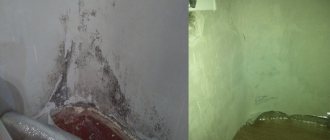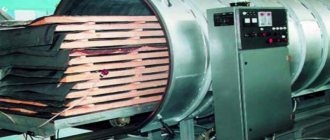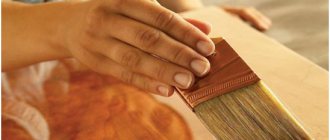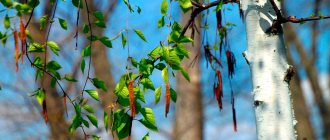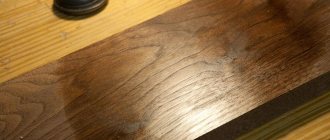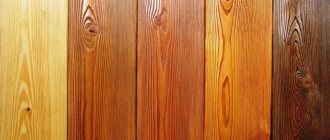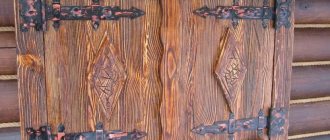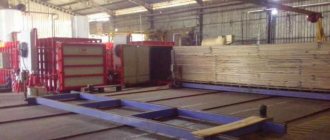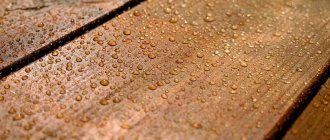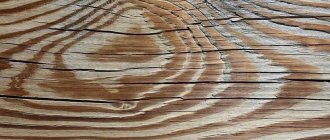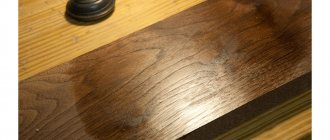Wood has been the main building material used for the construction of houses and other vital structures for many years. It is suitable for use in different climatic zones. The main advantage of building houses, bathhouses, and summer houses from this material is the cost-effectiveness and speed of construction. Despite its advantages, lumber has its disadvantages. The main one is the susceptibility of wood to rotting and fungus formation. Wood-shaving products absorb moisture well, as a result of which mold appears on the boards, and then on the walls of the house.
When faced with a problem, many people have no idea how to treat the wood so that the characteristic blackening does not occur. There are many ways to get rid of fungus, but before treating the material, you need to prepare and identify the causes of rot on the surface. In addition, they additionally check and regulate the operation of heating, water supply and other basic home supply systems.
Reasons for appearance
Most often, brown mold and other types of fungi appear on the surface of boards due to excess moisture. If the spores were initially on the tree bark, then immunity did not allow the mold to spread further. As soon as the plant has been cut down, the mycelium begins to actively multiply on the materials if they are not treated with anything.
Rot appears on lumber that has been on damp, damp soil for a long time. This happens if the tree was left outside without shelter or if the raw material was felled and lay on the ground for a long time.
If all of the above methods of colony entry are excluded, then we can safely say that the spores got onto the boards by air, and their reproduction was favored by other environmental factors.
Lumber “blooms” in the following situations:
- The fungus actively reproduces in humid environments, as well as in places where there is no air circulation. High humidity indoors (more than 60%) or outdoors creates an ideal microclimate for the development of microorganisms.
- The appearance of black spots can be caused by a sudden change in temperature and the formation of condensation. This problem is especially relevant when wood is stored in a house or heated outbuilding, where the heating system is periodically turned off.
- Wood exposed to prolonged frosts is more susceptible to the penetration of parasitic fungi inside. This happens when the boards are in the basement. Mustiness and dampness stimulate the proliferation of microscopic pests.
If the surface of the building material is not treated in a timely manner, the fight against plaque can take a long time. The thing is that the spores do not remain at the top, but gradually penetrate inside, affecting the internal fibers of the lumber.
All these reasons together can create serious consequences associated with the appearance of black spots. If it turns out that the building materials are covered with rot, then it is necessary to begin an active fight - buy antiseptics and fungicides. But first things first.
Prevention
It is easier to prevent the appearance of fungus on a tree than to get rid of it. To do this, you should follow simple recommendations:
- Regularly prune branches in spring and autumn to avoid thickening the crown.
- Collect fallen leaves under a tree: pathogenic microorganisms often overwinter in them.
- In spring, whiten the trunks.
- Place traps for aphids and other small insects, since the appearance of fungus on fruit crops is often associated with parasite damage.
- Remove weeds in the tree trunk area.
- Monitor the occurrence of new lesions, hollows, cracks. Clean them immediately and treat them with garden varnish or paint.
- Use chemicals or biological products for preventive treatment of plants.
- Avoid frequent watering and high humidity, which is one of the reasons for the development of fungal infections.
Related article:
You need to know the enemy by sight! 7 most dangerous pests in the garden and garden
Diseases can seriously harm trees. It is better to resort to preventive measures. But if the fungus does appear, you need to start treatment immediately.
In the bath
Another place where black mold can appear and actively reproduce is a bathhouse. If you follow all the rules for the construction and operation of this part of the house, infection will not appear on the walls. Usually, when building a bathhouse, only the highest quality material is used, but due to excess moisture, high temperature conditions and violation of basic operating rules, spores quickly penetrate the fibers.
In this case, using the bathhouse is strictly prohibited, since along with the steam, microscopic particles enter the lungs and cause severe allergies.
The natural thirst for life of moldy mycelium can damage supporting structures, cause them to rot, and also disrupt the integrity of the wiring, which is unsafe due to the likelihood of a fire.
It is very difficult to get rid of infection in a bathhouse, since afterwards you will need to constantly monitor to ensure that the fungus does not return again. The owner will have to regularly inspect the floorboards on the wooden floor and other parts of the building.
Mold can be removed using several classical methods of control, including household chemicals and traditional medicine. But first of all, we check the attic, which must be insulated from the steam room even when the door is opened. If this is not the case, then condensation will constantly accumulate on the inside of the roof, feeding the rot.
In this situation, it is necessary to waterproof the premises - use a so-called vapor barrier mat, which is spread over the entire contact area.
Without eliminating technical faults, it will not be possible to remove disputes. If the situation has been corrected as much as possible, we move on to the next stage.
Why does wood deteriorate?
Mold reproduces by spores and even “healthy” boards can become covered with unsightly blue spots over time. Such disputes exist everywhere - on roads, fields and forests. At the same time, the types of mold that live in forest plantations actually cover 40% of the branches and trunks. Spores can easily enter the home via pets, wind, and shoes. When microorganisms penetrate into housing, where conditions are favorable for active development (humidity 70%, temperature in the range +5...+30 ̊C), they grow. Mold on wooden coverings and cladding materials occurs in the following situations:
- the house is not heated regularly;
- do not monitor the condition of the basement;
- ventilation is not organized correctly;
- wooden surfaces are not treated with specialized compounds;
- do not pay attention to the condition of the foundation.
Inside homes, the fungus most often affects wood and other surfaces in damp places, usually bathrooms. Most often, ventilation problems are also the cause. This is because when air does not circulate, mold colonies grow very quickly. In addition to the above, the cause of mold stains is often violations or a complete lack of waterproofing.
Fighting methods
In addition to knowing what products will help remove fungus from wood, you need to know what stages the processing of boards includes. Undoubtedly, it is best to work with a board at the stage of its manufacture (ideally, buy it at a sawmill) or purchase it from a well-equipped warehouse. In this case, the building material is simply dried and, if necessary, opened with special antiseptic compounds.
If building materials have already been used during the construction of the building, then first of all it is necessary to take care of normalizing the level of humidity in the room and the correct temperature conditions. Only in this case will household chemicals help cope with the problem. The next step is disinfection of the surface.
Experts recommend first using more gentle methods of influence - folk recipes, which include natural ingredients such as lime, soda, vinegar, etc.
And only after such treatment has not brought tangible results, one should move on to radical methods of struggle.
Processing Features
The film formed on the wooden surface reliably protects the material from moisture and pests. However, the main difficulty in processing lies in the uniform distribution of the protective material over the entire surface. The problem is all kinds of unevenness in the wood. Achieving the desired effect is largely determined by the properties of the chemical - its density, viscosity, humidity and surface activity.
Different wood species respond differently to impregnation. For example, coniferous trees are the most difficult to treat with antiseptics. Also, the deep layers of wood of some deciduous trees, such as oak, birch, ash, elm or beech, have a high level of resistance to antiseptic agents.
To a large extent, the ability of a raw material to absorb an antiseptic is dictated by its moisture content. For this reason, before antiseptic and canning, the material is dried and only then subjected to chemical treatment.
Folk remedies
In order to effectively remove mold from a wood surface, it is not necessary to spend a lot of money on purchasing professional mixtures. Often all the components are at home and you just need to know how to mix them correctly.
These ingredients include:
- hydrogen peroxide;
- copper sulfate for wood processing;
- table vinegar 9%;
- borax;
- ammonia;
- drying oil or glue;
- baking soda;
- sodium bichromate;
- resin;
- liquid soap;
- boric acid;
- bleaches containing chlorine;
- iodized salt.
Silicate glue is not used in concentrated form; the substance is diluted with distilled water in equal proportions. The resulting slurry is applied to the surface of the wood. For more detailed instructions, see the end of the article.
Copper sulfate is an effective chemical, but it also should not be used in its pure form. One hundred grams of powder is dissolved in ten liters of water. Afterwards, the mixture must be poured into a spray bottle. The liquid is used to treat wood, as well as walls, slopes and ceilings.
Resin is also an effective method of control, but it cannot be used within a residential area. All treatments must be carried out outside the premises.
Before removing the black spots, pay attention to how deeply the infection was able to penetrate inside. If the situation is quite advanced, then traditional methods cannot be used and you will have to resort to radical measures - mechanically remove part of the damaged material (with a plane, saw, ax), and it is better to throw away the boards that are too contaminated.
Why fight mold?
A typical question that can be heard from people, especially young people and without much life experience, is why fight fungal infections that have already appeared and, moreover, spend money and time on some kind of prevention. In fact, it is a very justified investment, which, ultimately, will allow you to avoid domestic disasters and problems with the health of the skin, respiratory and immune systems in the future. And much more money spending, by the way...
Molds are microorganisms of various types that parasitize on various surfaces, penetrate their internal structure and destroy them.
In relation to wood, the decomposition of the internal structure in the process of mold rotting weakens the structural element, making it brittle and unable to withstand design loads; as a result, one can find many examples of serious destruction of the entire structure or some part of it - most often the roofing and rafters, which is overwhelmingly in most cases it is constructed from wooden elements.
In this article, we are not as interested in the scientific names and classification of fungi that lead to biocorrosion of wood structures as we are in methods of identifying, controlling and preventing it. This is exactly what we will do.
How to process
For better processing, it is better to take the product outside. However, if this cannot be done for some reason, we open the windows and doors, ensuring free air circulation. To prevent mold from spoiling the structure of the tree, you need to carry out a number of procedures in the correct sequence. Remember to use personal protective equipment and wear gloves.
First, clean the affected area with a spatula or a hard-bristled brush. Next, the surface is primed with a deep penetration compound. After it dries, the finishing coat is applied. This is enough to remove mold from wood forever.
Preservation and application of antiseptic
Treatment of spores can be carried out using several methods. The most effective of them is conservation. This means that the fungus and the materials on which it lives will be coated with a special, long-lasting fungicidal composition. Gradually, without oxygen access inside, the mycelium will die.
Treatment for fungus and mold may be different. The infection is exposed to a steam bath or a special diffusion impregnation is done. An alternative to this is applying an antiseptic solution; the procedure can be done at home, without the help of professionals. On the shelves of hardware stores there are both expensive and cheap mixtures, but in essence they are the same.
The prepared product is applied to the affected areas on the wood with a regular roller or wide paint brush. The choice of antiseptics is wide and varied. Moreover, modern formulations do not have a strong odor and are therefore safe for use. They do not contain toxic chemical compounds that can harm humans if inhaled.
Wood antiseptic is the best remedy for combating microscopic fungi. This group includes water-repellent, water-soluble, combined and oil-based substances, each of which is suitable in each individual case and is therefore selected individually.
How to get rid of mold and mildew on wood floors
Linoleum is laid on any surface for practicality and design. If the installation technology has been violated, mold may penetrate onto the chipboard under the linoleum (as well as onto other surfaces). It is almost impossible to detect it immediately. People begin to notice the problem when it smells strongly. When asked what to do if the linoleum stinks of mold, it is most often recommended to throw away the coating and replace it with a new one.
Wooden floor
What to do with a wooden floor in this situation is described above, in the section telling how to destroy the fungus under the floor and on its surface. The owner's actions will depend on the degree of damage to the material by spores. But in this case, it is better to treat not only the visible affected areas, but the entire wooden floor.
Concrete floor
Mold “bites” into concrete more slowly than into wood, but it will be more difficult to remove the unpleasant black coating from such a base - after all, you will have to clean off at least 2 cm of the layer. To do this, it is recommended to use a sander, which, unfortunately, produces a lot of dust (you will have to work with maximum protection).
Then the concrete floor is treated with an antiseptic. It is best to use a professional instant-action product that fights spores and immediately creates a special protective film on the surface (a fairly effective product is “SZAVO”).
We recommend watching an excerpt from the program on how to get rid of fungus on the floor.
Elimination of consequences and prevention of further proliferation of fungal spores is carried out in several stages. How to remove mold from a wooden surface if the problem is found in a neglected state:
- Cleaning damaged areas. You will need a spatula and a chisel. Remove the top layers with a spatula. A chisel and knife are used if damage to the internal structure of the wood is detected.
- Dispose of all removed wood. It is advisable to burn all cut layers of wood.
- Washing the material. Prepare a concentrated solution of laundry soap and carefully treat cleaned wooden surfaces.
- After treatment with soapy water, the wood is allowed to dry. Then they are treated with a wood antiseptic. After disinfection, the wood is allowed to dry and the treatment of problem areas is repeated.
If the material is only slightly affected, the following will help get rid of mold:
- chisel and spatula;
- sandpaper;
- hammer;
- soft rags and fine sandpaper.
The scale of mechanical intervention depends on the depth of penetration of fungal spores. Sometimes it is enough to remove the thin top layer and then perform disinfection without severe damage to the timber.
Antiseptic
A properly selected chemical solution will destroy mold growth areas. As a rule, universal antiseptics and active fungicides are used for these purposes. The following have proven themselves well in the fight against disputes:
- Tikkurila;
- Belinka;
- Neomid.
These antiseptics do not contain dangerous chlorine compounds and volatile toxins. At the same time, they are capable of not only destroying areas of bacterial growth, but also subsequently protecting the wood from spores. In addition, there are solutions that additionally have a toning effect. This allows the lumber to retain its natural appearance.
Folk remedies
Before treating the timber against fungus and mold using professional means, you can try traditional methods of combating it. Such means were successfully used for control even before special chemical solutions appeared on the construction market. Among the most popular are the following:
- Acetic acid. Lumber is treated with acetic acid in two stages. Spraying is performed for the first time. After complete drying, wipe again with a dampened rag. This method is completely safe, but gives a short-term effect.
- Hydrogen peroxide. Carefully treat the damaged areas with peroxide and leave for 15 minutes. Then clean the surface with a metal brush. The disadvantages include the risk of losing the appearance of the material.
- Baking soda. Add water to the soda and stir thoroughly until a thick paste is obtained. The product is applied to the damaged areas and left for 30 minutes. Then the surface is cleaned with a stiff brush.
- White. The most effective and most dangerous way to destroy mold fungi. Whiteness is applied to the areas where spores have been identified and left for 15 minutes. Wash off with soap concentrate.
Folk remedies are not always effective, and in some cases even dangerous to human health. Therefore, it is better to give preference to modern antifungal drugs with a multicomponent composition.
